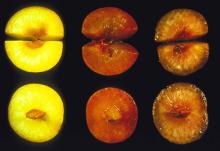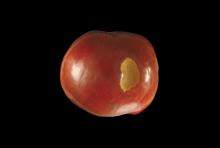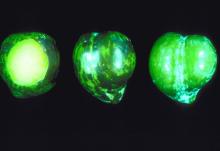Índices de madurez
In most of the cultivars growing in California, harvest date is determined by skin color changes that are described for each cultivar. A color chip guide has been designed to determine maturity for each cultivar.
A three tier maturity system is used in California:
- US-Mature (Minimum Maturity)
- Well-Mature
- Tree Ripe
Measurement of fruit firmness is recommended for cultivars where skin ground color is masked by full red or dark color development before maturation.
Maximum maturity. Flesh firmness, measured with a penetrometer with an 8 mm-tip, can be used to determine a maximum maturity index, which is the stage at which fruit can be harvested without suffering bruising damage during postharvest handling.
Plums are less susceptible to bruising than most peach and nectarine cultivars at comparable firmness.
- igh consumer acceptance is attained on fruit with high soluble solids content (SSC)
- Fruit acidity, SSC/acidity ratio, and phenolic content are also important factors in consumer acceptance
- There is no established minimum quality standard based on these factors
- Plums with 2-3 pounds - force flesh firmness are considered "ready to eat"
Manejo y almacenamiento poscosecha
-1.0 to 0°C (30.5-32°F)
Freezing point varies depending on SSC.
| Temperature | 0°C (32°F) | 10°C (50°F) | 20°C (68°F) |
| ml CO2/kg·hr | 1-1.5 | 4.2 | 8.2 |
To calculate heat production multiply ml CO2/kg·hr by 440 to get BTU/ton/day or by 122 to get kcal/metric ton/day.
Most of the plums harvested at the California Well-Mature stage (higher than US-Mature) will ripen properly without exogenous ethylene application. Ethylene application to fruit harvested at the US-Mature maturity will only ripen the fruit more uniformly without speeding up the rate of ripening. However, for the slow ripening plum cultivars, expgenours application of ethylene (100 ppm for 1-3 days at 20°C/68°F) is needed for even ripening. These cultivars are Angeleno, Black Beaut, Casselman, Late Santa Rosa, Kelsey, Nubiana, Queen Ann, Red Rosa, and Roysum.
90-95% R.H; an air velocity of approximately 50 CFM is suggested.
| Temperature | 0°C (32°F) | 5°C (41°F) | 10°C (50°F) | 20°C (68°F) |
| µl/kg·hr | < 0.01-5* | 0.02-15 | 0.04-60 | 0.1-200 |
*The lower end of this range is for mature but unripe fruit; higher values are for ripe fruit.
The major benefits of CA during storage/shipment are retention of fruit firmness and ground color. Decay incidence has not been reduced by CA of 1-2% O2 + 3-5% CO2. CA conditions of 6% O2 + 17% CO2 are suggested for reduction of internal breakdown during shipment, but its effectiveness depends on cultivar, preharvest factors, market life and shipping time.
Effects of Genotype and Cultural Cultivars in California
Market life varies among cultivars and it is strongly practices on affected by temperature management. Maximum market life is obtained when fruit are stored at approximately 0°C (32°F). Maximum market life varies from 1-8 weeks. Because internal breakdown is the main limitation to market life, minimum postharvest life occurs when fruit is stored at 5°C (41°F).
Temperature & Controlled Atmosphere Photos

Title: CA Effects (1) Photo Credit: Don Edwards, UC Davis |

Title: CA Effects (2) Photo Credit: Don Edwards, UC Davis |

Title: CA Effects (3) Photo Credit: Don Edwards, UC Davis |
Desórdenes
Internal Breakdown or Chilling Injury. This physiological problem is characterized by flesh translucency, flesh internal browning, flesh mealiness, flesh bleeding, failure to ripen and flavor loss. These symptoms develop in plum and fresh prunes during ripening after a cold storage period. Thus, these symptoms are usually detected by consumers. Fruit stored within the "killing temperature range" 2-8°C (36-46°F) are more susceptible to this problem.
Brown rot. Caused by Monilia fructicola is the most important postharvest disease of stone fruits. Infection begins during flowering and fruit rot may occur before harvest but often occurs postharvest. Orchard sanitation to minimize infection sources. preharvest fungicide application and prompt cooling after harvest are among the control strategies. Also, postharvest fungicide treatment may be used.
Gray Mold. Caused by Boyrytis cinerea can be serious during wet spring weather. It can occur during storage if the fruit has been contaminated through harvest and handling wounds. Avoiding mechanical injuries and good temperature management are effective control measures.
Rhizopus Rot. Caused by Rhizopus stolonifer can occur in ripe or near ripe stone fruits kept at 20 to 25°C (68 to 77°F). Cooling the fruits and keeping them below 5°C (41°F) is very effective against this fungus.
[For more information, see our publications “ Fruit Ripening & Ethylene Management ”, and “ Peaches, Plums, and Nectarines-Growing and Handling for Fresh Market ”, available for purchase using our Order Form.]













